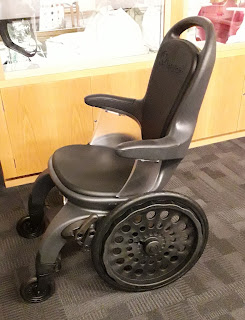I have recently been in the position of caring for someone
whose mobility has been somewhat compromised and consequently I have discovered
some of the ‘delights’ of using a wheelchair to help with this. I appreciate that there are a lot of
wheelchairs available for a whole range of different needs and uses, but the
ones I have been using have been either the 'fold it up and put it in the boot
of the car' sort for those times when it is just too far to walk for the person
I have been assisting, or the 'one-size-fits-all' porter style, helpfully
provided by the NHS to assist with getting from A to B down the miles of
hospital corridors. Neither of these two options are an enjoyable experience
either for the chair user or for myself, having to cope with somewhat basic
design and function. Nevertheless, the wheelchair has proved to be an
invaluable aid and we are grateful for having access to one when needed.
There is, I have discovered, a rather more
swish model on the market, specifically for use in hospitals, airports, pools
etc, less institutionalised in appearance and one that offers
a thoughtfully designed user experience for those occasions where materials
from which wheelchairs are usually made just won’t do. It has been on the market for over a decade
now and has had remarkably few problems or faults in that time.
The EasyRoller 2 is made completely from plastic materials. It is intended for use in situations like MRI scanning rooms in hospitals and airport security where metal framed chairs could be a problem. It is also perfect for assisting those with mobility difficulties to get into a swimming pool. For pool use, the chair is available without seat and back padding to avoid buoyancy, and to stabilize it in the water there is a mounted weight under the seat. Cavities in the chair quickly fill with water which drains away easily and there are no metal parts which might be affected by chlorine or corrode, so the chair can be wheeled directly into the pool. Every part is water resistant, including the padding on the seat and armrests, so the chair can be wiped or hosed down to clean.
As far as wheelchairs go, it is rather
elegant. It has a supportive high back
and a wide comfortable seat and is designed to offer a better user
experience. It is very easy to
manoeuvre. The handle, for someone pushing, is integrated into the back rest,
the breaks are easy to access and the footrest rotates backwards when not
required. There are no extra bits which
need clipping on: its all there ready to
go. OK, so its not suitable for putting in the boot of the car, and it isn’t intended
for someone who uses a wheelchair all the time, but that’s not what it was
designed for, and if I needed a wheelchair to help me negotiate airport
security, hospital corridors or into the pool then I think this is the one I
would want to be offered. …….and MoDiP now has one in its collection.
The EasyRoller 1 began development in 2000 and was first
introduced for sale in 2001. The EasyRoller 2 was developed in 2009. It was
designed and developed by Eker Design in Norway and is produced in Germany. In
July 2011 Eker Design was awarded the Red Dot design award for the Easy Roller,
recognising its outstanding design and engineering, with the jury highlighting
'functional elements such as the steering handle, armrest and tipstop (which)
are intelligently integrated into the design, lending the wheelchair an overall
welcoming appearance'. In the same year it also achieved an Honours Award for
Design Excellence from the Norwegian Design Council.
I think this is a great example of the choice of the best materials for a particular application. In the current climate, where some plastics have a bad reputation, this wheelchair exemplifies why designers choose to work with plastics over other materials and why, in this instance, they really are the best material for the job.
Pam Langdown
Documentation Officer
Documentation Officer




This comment has been removed by a blog administrator.
ReplyDelete